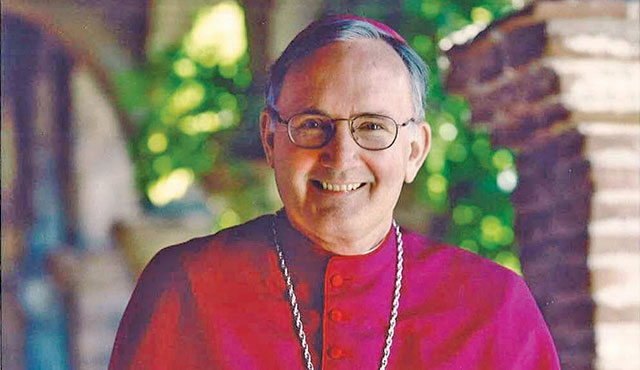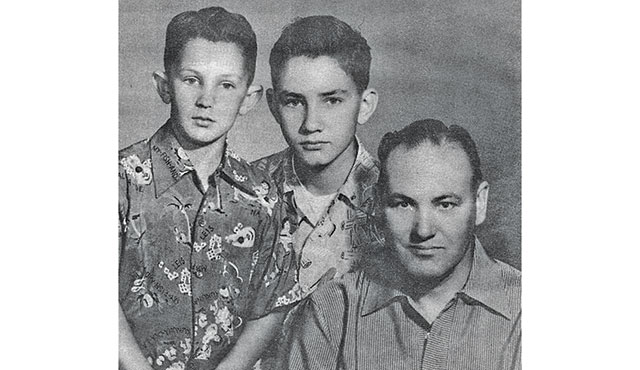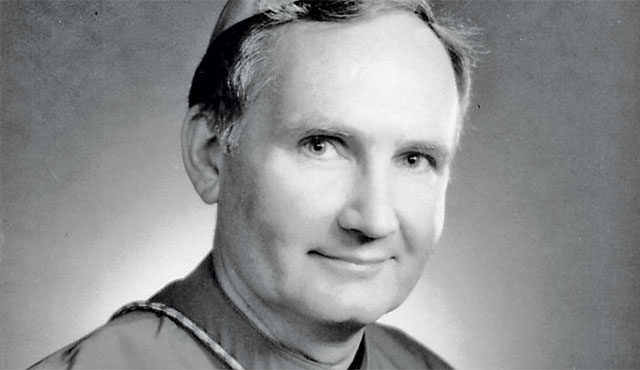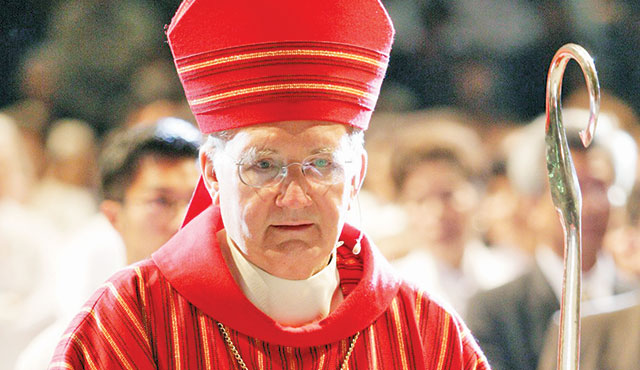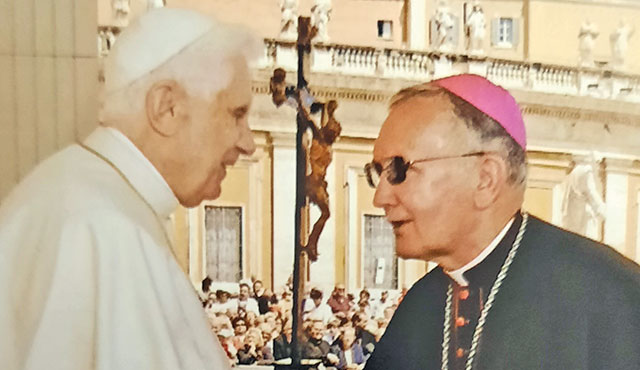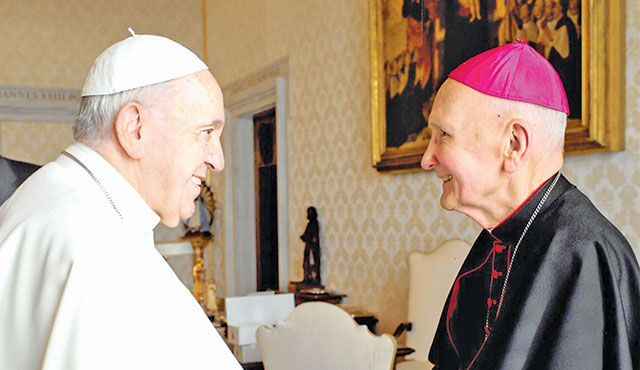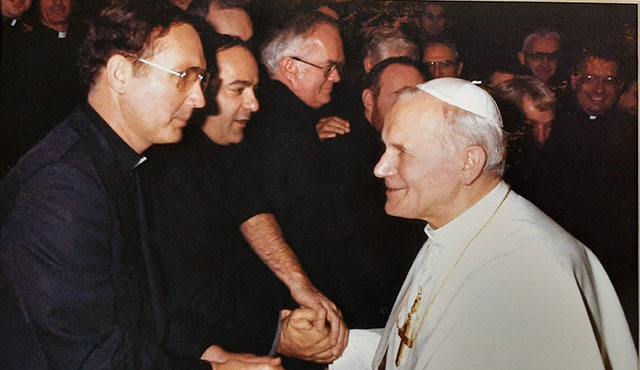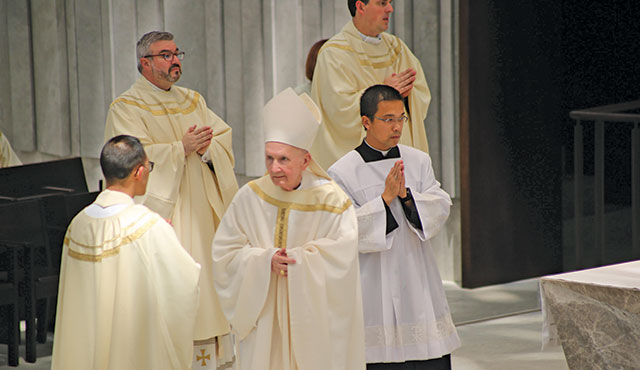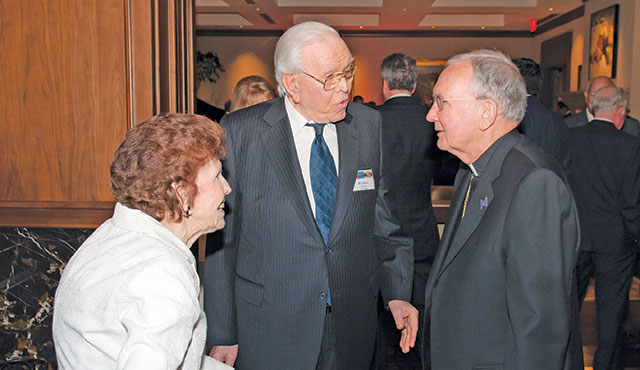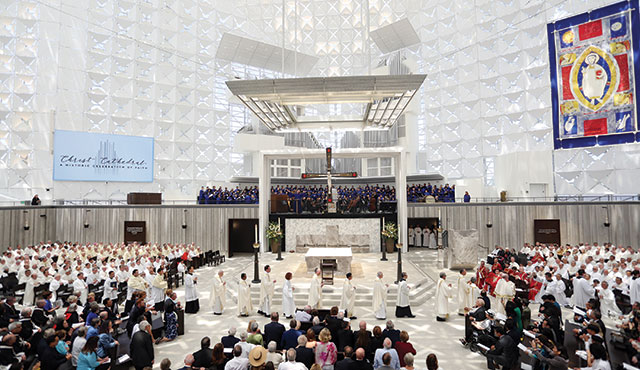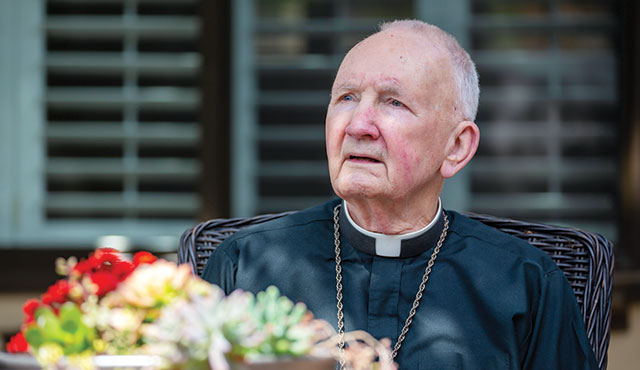Tod David Brown never expected to be a bishop.
The first call came in late in the evening as a red blinking light lit the hotel room phone. He did not answer thinking it was a scam call. The phone rang again and he answered. Archbishop Pio Laghi, the Vatican’s diplomat to the U.S., was on the other end.
“I have good news for you today,” the archbishop told then-Monsignor Brown, at that time the vicar general of the Roman Catholic Diocese of Monterey. “The Holy Father has nominated you a bishop.”
Brown was announced 10 days later as the sixth bishop of the Diocese of Boise.
“There’s a great need for you in Monterey, but there’s a greater need for you in Boise,” Archbishop Laghi told Monsignor Brown.
After leading the Diocese of Boise for nearly a decade, Bishop Brown received another message from Pope John Paul II – this time delivered by Archbishop Agostino Cacciavillan, the papal representative (nuncio) to the United States of America at a U.S. Conference of Catholic Bishops meeting in Pittsburgh.
The archbishop pulled Bishop Brown aside, asking him to take on a new assignment leading Orange County’s fast-growing and diverse Catholic community.
Accepting the assignment as Bishop of Orange, he guided the Diocese through an unprecedented period of growth and transformation, and dealt with a dark period of scandal as well.
“He did a lot to raise the quality of Catholic life in Orange County,” said Msgr. Kerry Beaulieu, a close friend who retired in 2018 after serving 44 years as a priest. “He brought the Diocese of Orange to the next level.”
Born in San Francisco on November 15, 1936, Brown was raised by his parents, George Brown, an accountant and business man, and Edna, a social worker, alongside his younger brother, Dan. The family first lived in the San Francisco Bay Area, before settling in Santa Cruz, about 75 miles south of San Francisco. The family was close.
“He’s had a big influence on my life,” said Dan Brown. “He is a good brother and a good person. He’s very thoughtful. We always got along well.”
Brown went to high school at Ryan Preparatory College, a diocesan seminary staffed by the Jesuits, where the seed of life as a priest was first planted.
“I felt early on a calling to the priesthood,” Bishop Brown said during a recent interview. “I prayed about that, discerned and thought I would try it out. My parents weren’t real keen on it at first, but they went along with it.”
First communion is among his earliest memories. His faith grew strong. After 6 years at Ryan Preparatory College, Brown studied at St. John’s Seminary in Camarillo. But as his education continued, he considered other lines of work: medicine, law and education.
He took a one-year break from the seminary to follow his mother’s path and serve as a social worker in Santa Cruz, working with impoverished single mothers. The assignment gave him a glimpse of life as a parish priest.
“It was challenging work and a good experience,” he said.
After earning bachelor’s degrees from St. John’s Seminary and the Pontifical North American College, and the Gregorian University in Rome, Brown was ordained to the priesthood on May 1, 1963 for the Diocese of Monterey-Fresno.
“It was something I had waited, hoped and prayed for,” he said. “Bottom line, I felt I could best serve other people and God by being a priest.”
Father Brown was assigned to serve in Bakersfield and then at St. Francis Xavier Catholic Church in Seaside, a growing middle-class community in Monterey County. The parish was home to African-American, Filipino and white military families from Fort Ord, a now-defunct army base. For Fr. Brown, working in a diverse parish was an exhilarating start to life as a priest and his first experience ministering to a vibrant community of Catholics. Seventy-two countries were represented among the parishioners of different backgrounds. The parish would become a new home for him.
“It was a whole new experience for me — one that I enjoyed very much,” he said. “It was very challenging, but also deeply rewarding and interesting. I found the people warm and accepting.”
As a young priest, he focused on conducting worship services and ministering to parishioners. He had no ambitions on rising through the Diocesan hierarchy.
“I just wanted to be a good priest,” Fr. Brown said. “I tried to be a bridge and listen to people.”
After about two years in Seaside, he enrolled at the University of San Francisco to earn his master’s degrees in biblical theology and education. He then returned to the Diocese of Monterey, eventually holding key leadership assignments. His first as the Director of Education. Assignments on diocesan committees included the Divine Worship Commission, Presbyteral Council and the Board of Education.
But his heart was in Seaside. His bishop assigned him as pastor at St. Francis Xavier, which continued to grow. With the army base and service language school nearby, Seaside was home to a booming number of refugees fleeing the Vietnam War. Soon, Mass was being held each week in Vietnamese.
“That was my first experience working with Vietnamese parishioners which, as it turns out, was providential,” he said.
An effective priest and popular leader, Fr. Brown would go on to serve the Diocese as chancellor under Bishop Harry Anselm Clinch, and later moderator of the curia and vicar general, the second-in-command under Bishop Thaddeus Anthony Shubsda. And in 1987, while serving as vicar general, he helped oversee a visit by Pope John Paul II to the Monterey peninsula during his landmark California trip.
During the brief visit, Pope John Paul II prayed at the grave of St. Junipero Serra and celebrated Mass at Laguna Seca Speedway with 50,000 worshippers.
“It was extraordinary and overwhelming,” he said.
Just more than a year later, Pope John Paul II appointed Fr. Brown as bishop of Boise, Idaho.
BISHOP OF BOISE
Bishop Brown was installed on April 3, 1989 as the sixth bishop of Boise, Idaho, succeeding Bishop Sylvester Treinen.
“I had some apprehension,” Brown said. “Starting a new situation, not knowing the culture or the state. It was not easy. I didn’t know anything about the Northwest.”
With 75,000 Catholics, the Diocese of Boise included 72 parishes across the state.
“During confirmation season, I’d live out of my car,” he said. “There was a lot of time on the road.”
Much of the state’s population was Mormon, and members of the Church of Jesus Christ of Latter Day Saints wielded wide influence, holding political majorities on city councils and school boards.
“I was really impressed with the faith of the Catholic people — they were warm and welcoming,” Bishop Brown said. “My relationship with the Mormon leadership was very positive.”
Catholics in Idaho represented about 10 percent of the state’s total population, with fast-growing numbers of Hispanic residents. His focus as bishop included fostering positive relationships between Catholics of different ethnic backgrounds and overseeing sweeping administrative changes and securing the financial operations of the Diocese. He also sought to strengthen ties between Catholics and Mormons. For the new bishop, it was the start of a focus on ecumenism and inter-religious dialogue. Something he had done in Monterey that would span the rest of his career.
“I felt that I made a positive contribution to the Catholic Church in Idaho,” he said.
After 9 and a half years, Bishop Brown received his new assignment from Pope John Paul II to lead the Diocese of Orange.
“I was happy to come back to California,” he said.
BISHOP OF ORANGE
Shortly before he was installed as Bishop of Orange, Bishop Brown met Rev. J. Michael McKiernan. They formed a close friendship.
“From almost day one, my experience of him was of a man who was thoughtful, collaborative, always wanted my opinion and would often hesitate before he tells me what he thinks,” said Msgr. McKiernan, who served as Bishop Brown’s secretary when he joined the Diocese in 1998 through 2005. (Father McKiernan was named monsignor in 2009.)
Among Bishop Brown’s first requests when he arrived in Orange County was to visit the grave of the diocese’s first bishop, William Johnson, at Holy Sepulcher Cemetery in Orange.
“That set the tone for his respect and understanding of whose steps he would follow,” Msgr. McKiernan said.
Brown began his tenure as the third Bishop of Orange at a time of unprecedented growth and extraordinary challenge.
He was installed on a sweltering late-summer afternoon on Sept. 3, 1998 at Holy Family Cathedral in Orange.
“The bishop, as pastor of a local church, is called the shepherd of his people – to lead them, care for and protect them, and help them grow in their faith in Christ Jesus,” he said at the time of his installment, according to the Orange County Register.
With the Orange County’s population rising, parishes saw increased Mass attendance and greater diversity among parishioners. During Brown’s 14 years as bishop, the county’s Catholic population doubled to 1.2 million.
Bishop Brown’s experiences working in the diverse communities of Monterey Bay guided him in Orange County.
“The cultural, racial and ethnic diversity in the Diocese of Orange is a great gift,” he said. “It represents the diversity of the universal church.”
Throughout his 14 years as Bishop of Orange, he was known as a collaborative leader who embraced diversity, hiring women to key Diocesan leadership positions, a practice that continues to this day
“He always tried to find a pastoral approach to his ministry,” said former Diocese of Orange Chancellor Shirl Giacomi. “He valued having women in leadership positions and listening to their point of view.”
Bishop Brown was widely respected among Catholics across Orange County, especially diocesan clergy and staff.
“He wasn’t a boss, he was a leader,” said Msgr. Tuan Pham, who served as the bishop’s secretary from 2005 – 2011 and is now pastor at St. Columban Catholic Church in Garden Grove. “Even though he was bishop, he never looked down on anyone or viewed their job as a lower position. I learned a lot from him. As a pastor, I treat people the way he treated me.”
Fr. Pham worked with Bishop Brown to form a sister diocese relationship with the Archdiocese of Hanoi and foster ties with Orange County’s large Vietnamese community. The two men lived in the same house in Santa Ana and made it a point to pray together every morning and night, regardless of how busy their schedules were.
“I believe prayer helped him through the stress he had to face,” Fr. Pham said. “He’s a spiritual man and a good role model. We became very close friends.”
Aiming to ensure leaders reflected the community they served, Bishop Brown in the late 1990s requested of the Holy See a Hispanic auxiliary bishop. Pope John Paul II named Stanton native Monsignor Jaime Soto to this position in 2000, making him one of the few Hispanic bishops in the U.S. at the time. Bishop Soto is now bishop of Sacramento.
In the early 2000s Bishop Brown requested a Vietnamese auxiliary bishop to be named to the Diocese of Orange. The same pope, Pope John Paul II, nominated Dominic Luong, then serving in New Orleans, as an auxiliary bishop in Orange, making him the first Vietnamese Roman Catholic bishop in the U.S.
“He trusts other people and believes in their ability to do their jobs responsibly,” said Rev. Binh Nguyen, who served as Brown’s secretary for his final 18 months as bishop. “The people he chose to be in leadership positions exemplified that.”
Affable, thoughtful and reserved, Bishop Brown is known for his collaborative spirit and willingness to listen to others and carefully consider their opinions before making decisions. He enjoys travelling abroad and has a quick, dry sense of humor.
“He is a gentle and quiet person,” said Msgr. Beaulieu, who remains a close friend.
The two would often have lunch together, driving across Orange County in search of the perfect enchilada.
“I’m not sure he ever found it,” Msgr. Beaulieu said. “It’s his Holy Grail.”
Bishop Brown made it a point to visit every parish his first year as bishop to meet as many parishioners as he could, and always took time to help others facing personal and spiritual challenges — especially clergy.
A friend of Msgr. McKiernan’s was once struggling while studying to become a priest. Msgr. McKiernan suggested he speak to Bishop Brown.
After the visit, Msgr. McKiernan’s friend looked like a different person, a smile on his face. His dream of becoming a priest had been renewed.
“(Bishop Brown) was able to step back from himself and listen to others,” Msgr. McKiernan said. “He has a love and deep respect for the priesthood.”
Bishop Brown and Msgr. McKiernan prayed together each morning. In the evenings, the Bishop often had priests and diocesan staff over for dinner to show his appreciation for their work and to get to know them better.
He was popular with the priests he led, and is credited with working to increase the ranks of priests and seminarians while he was bishop.
“He worked very hard and gave a lot of himself,” Msgr. Beaulieu said. “He was more of an introverted personality, and people sometimes misunderstood him because of that. Although he was shy, he established positive relationships with others. He always tried to listen and help.”
“And he acted boldly when he needed to,” Msgr. Beaulieu added.
PRIEST ABUSE SCANDAL
As Orange County’s Catholic population grew, darkness loomed. The Diocese was not spared from the news of the sexual abuse scandal that broke in Boston in early 2002.
“The sexual abuse cases were a terrible tragedy,” Bishop Brown said.
In 2005, Bishop Brown became the first bishop in California to settle sex abuse claims, agreeing to pay $100 million to 90 victims and publicly releasing files on clergy abuse allegations, some of which occurred prior to 1976 when the Diocese of Orange was created from the Archdiocese of Los Angeles. At the time, it was the largest abuse settlement payout in the U.S. Catholic Church.
When considering the settlements, Bishop Brown weighed the burden placed on victims who would have to endure lengthy trials.
“I decided to settle because I was very concerned about the victims,” Bishop Brown said, adding that insurance, which was exhausted as a result of the settlement, paid for about 50 percent of the settlement. “And I was also concerned about the stress and pressure it was putting on priests, deacons, our parishes and families. After consultation and prayer, I decided to make the move to settle. It wasn’t understood or appreciated by everybody, especially some of the other bishops.”
Critics said Bishop Brown wasted money fighting cases and protecting abusive priests. And although some believed the move to settle put added pressure on other dioceses to reach financial settlements with victims, Bishop Brown’s decision was praised publicly. After the Diocese of Orange announced the historic settlement with victims, other dioceses across California followed, including the Archdiocese of Los Angeles, which reached a $660 million settlement in 2007 with 508 people who alleged abuse.
“I made the decision in the context of prayer and consultation, and I have no regrets whatsoever. I believe I made the right decision.”
As part of the abuse settlement, Bishop Brown personally apologized to each of the victims. He also put in place a series of policies and procedures to ensure parishes and schools remain safe for both children and adults. The new protections included requiring stringent and comprehensive background checks for all clergy and lay employees, mandating safe environment training, creating a diocesan office dedicated to protecting children, strengthening abuse reporting education at schools and parishes, and establishing an independent Oversight Review Board comprised of volunteers to consider all allegations of sexual abuse of a minor presented against clergy or staff.
“I hope that what we have done — the changes we have made in our policies and our personnel practices — will guarantee that, as much as is humanly possible, these things will never happen again,” Bishop Brown said in a downtown Los Angeles news conference in January 2005, when the settlement agreement was announced.
Many of the policies first put in place in the Diocese of Orange have been replicated at other organizations and institutions across the U.S.
“He knew what we needed to do and he did it,” said Shirl Giacomi, who served as chancellor of the Diocese for 17 years, including during the abuse crisis. “He was very thoughtful and courageous.”
Bishop Brown’s handling of the abuse scandal will be central to his legacy leading the Diocese, those who know him said.
“When people look back at history, he’ll be remembered for his handling of the scandal with compassion, care and love for victims, and putting in place protections that we have now,” said Msgr. McKiernan, who served as the bishop’s secretary during the crisis. “He knew we needed to deal with the (sexual abuse) crisis head on – to not hide from it and to do best by those who were hurt. He wanted to make sure it never happened again.”
Bishop Brown was accused of abuse when he was a young priest in 1965, an allegation that was made while he was bishop of Boise, and dismissed after separate investigations by Church officials from the Diocese of Fresno, an independent diocesan sex-abuse review board and Kern County prosecutors.
He consistently denied the truth of the accusation, including under oath during a deposition in a separate lawsuit involving a lawsuit where someone else had been accused.
“I had been falsely accused,” he said. “The three worst and most painful days of my life are the death of my parents and the false accusation.”
“If I think about it, it’s still painful,” Bishop Brown added.
A NEW SPIRITUAL HOME
As the Diocese began emerging from the abuse crisis, a new focus was put on finding a spiritual home to accommodate Orange County’s growing Catholic population. Bishop Brown had long envisioned a new spiritual home, first eyeing a plot of land off Alton Avenue in Santa Ana, formerly owned by the Segerstrom family.
Although he was focused on building a cathedral in Santa Ana, he sought advice from others.
“He had his opinions, but he was open to listening, taking advice, praying on it, and choosing a direction,” Giacomi said.
A new opportunity soon appeared. In October 2010, the Crystal Cathedral in Garden Grove filed for bankruptcy protection in the face of soaring costs and a dramatic drop in revenue due to the recession. Offers began streaming in. Among those making offers were a Newport Beach-based developer, a Norco-based non-denominational church and Chapman University.
Bishop Brown was initially reluctant to join them in vying for the sprawling campus and historic building.
“I didn’t want to appear to be taking advantage of another church,” he said. “But the thought was that we wouldn’t have to build from scratch – everything would be already there.”
Bishop Brown had a good relationship with the founder of Crystal Cathedral Ministries, Rev. Robert Schuller. In the days after 9/11 (2001), the Diocese hosted an interfaith prayer service at Holy Family Cathedral in Orange. Schuller was in attendance, praying alongside the bishop and others present. Schuller later told a priest: “Bishop Brown is my bishop.”
Nearly a decade later, Bishop Brown and several lay advisors met with Schuller in his 12th floor office in the Tower of Hope. Crystal Cathedral Ministries had recently filed for bankruptcy. The group looked out over the manicured grounds and glass cathedral.
“They knew they had to let it go,” Bishop Brown said, adding that he weighed the costs of acquiring the property and maintaining it against the long-term benefits it would have for Catholics across Orange County and beyond. “Rev. Schuller wanted the property to continue to serve as a place of Christian worship and ministry. So we made an offer that would pay off all the debtors and ensure the property would continue its use as a church.”
Although the Crystal Cathedral’s board of directors initially voted to sell the property to Chapman University, they changed course the day before the bankruptcy hearing in federal court.
After an all-day court hearing on Nov.17, 2011, a federal judge approved the sale of 35-acre campus to the Diocese for $57.5 million. The property included the cathedral, memorial gardens, the Richard Neutra-designed Arboretum and Tower of Hope, the Cultural Center, designed by Richard Meier, and what is now called the Pastoral Center.
“Many people told me that it was worth twice what we paid,” Bishop Brown said, recalling a congratulatory phone call he received from Cardinal Timothy Dolan of New York, who said he thought it was the best property acquisition in U.S. history. “It was an incredible bargain.” The Rev. Rick Warren also phoned to congratulate Bishop Brown and mentioned that he had told Dr. Schuller earlier that he should sell the property to the Diocese of Orange.
Still, the acquisition required a large investment and Bishop Brown went to work raising funds behind the scenes, developing relationships with patrons who would support the cathedral far into the future.
“Christ Cathedral will be here for generations to come, and it will become – even more than it is now – the spiritual home of our Catholic Church in Orange County and a religious center for people of all faiths,” Bishop Brown said. “I think it will become one of the primary Catholic Cathedrals in the country.”
Bishop Brown’s resignation as bishop of Orange was accepted by Pope Benedict XVI on Sept. 21, 2012, in accordance with Canon Law, which requires all bishops to offer their resignation to the pope upon reaching their 75th birthday.
“When you retire as a diocesan bishop, you have to let go, and that’s not always easy,” now-Bishop Emeritus Brown said. “But you have to let go, like John the Baptist made room for Jesus.”
And after seven years of renovation work, Christ Cathedral was dedicated on July 17, 2019 as the seat of the Bishop of Orange and the Diocese’s spiritual home. Bishop Brown was among the nearly 3,000 in attendance.
“It was a very moving experience,” said Bishop Brown, who almost didn’t make it.
A few months earlier, he nearly died when an ulcer penetrated his intestine, causing septic shock. After being treated at Stanford University Medical Center, he recovered at a skilled nursing facility before returning to Orange County in time for the historic dedication.
“I was overwhelmed with gratitude to God,” he said.
Today, the Bishop Emeritus remains active, serving as a consultant with the United States Conference of Catholic Bishops committee on ecumenical and inter-religious affairs, visiting friends and colleagues across the Diocese and state. He serves as a chaplain for the Order of Malta, and is a member of the Knights of Columbus and the Knight and Dames of the Holy Sepulcher.
Those who know him say part of Bishop Brown’s legacy will center on his ability to lead the Diocese through the abuse crisis, acquiring Christ Cathedral property and charting the path for the Diocese’s future.
“He knew where he wanted us to go as a Diocese and how he wanted to get there, but was always taking in other people’s opinion,” Giacomi said. “He was one of the finest leaders I’ve ever worked with.”
Bishop Brown is most grateful for the friendship and support of his successor, Bishop Kevin Vann and for the ministry he continues to provide the church of Orange.
BISHOP BROWN’S ACCOMPLISHMENTS
- Starting the Orange Catholic Foundation, an independent nonprofit that works in collaboration with members of the Diocese of Orange to raise and manage funds supporting all aspects of the Catholic faith in Orange County. OCF was instrumental in raising funds to renovate Crystal Cathedral into a Catholic house of worship and offers continued support to Orange Catholic Schools.
- Forming a close relationship with the Archdiocese of Hanoi that provided financial resources, spiritual support and opportunities for Vietnamese priests to serve in Diocese of Orange parishes. Four priests from the Archdiocese of Hanoi are currently serving as priests in Orange County.
- Securing the property for the development of Clearwater at North Tustin, a senior living community, the first and only Catholic senior living community in Orange County. The facility is expected to open in September 2021.
- Establishing new parishes and Catholic centers to serve the county’s growing Catholic community, including Christ Our Savior in Santa Ana, Corpus Christi in Aliso Viejo, St. Thomas More in Irvine, Holy Trinity in Ladera Ranch and St. Thomas the Apostle Korean Catholic Center in Anaheim.
- Creating a pension plan and retirement program for diocesan priests and lay employees.
- Starting a partnership with Loyola Marymount University for lay diocesan staff to earn a master’s degree in Pastoral Theology, with the diocese paying a portion of tuition costs.
- Establishing a Diocesan Pastoral Council, an advisory group of parishioners that created the framework for the Diocesan Pastoral Plan, a roadmap for the future of the Diocese.
BISHOP BROWN’S FAVORITE SAINTS
- St. Junipero Serra – “The apostle of California, buried in Carmel Mission in my home Diocese of Monterey. I have great admiration for his missionary effort.”
- Fr. Damien de Veuster – “He lived an incredible life in service of the lepers in Molokai.”
- St. Marianne Cope- “She was a Franciscan sister and nurse who went to Molokai and was very dedicated to serving the lepers.”
- St. Francis Xavier – “The great missionary who went to Asia and the Orient. He was the patron of the parish where I was a priest in Seaside, California. His family crest is in my coat of arms.”
- Pope John XXIII – “Through the Second Vatican Council, he opened the church.”
- Cardinal John Henry Newman – “The great intellectual and convert from the Church of England who has a lot to tell us today even though he’s been dead all these years.”
BISHOP BROWN’S COAT OF ARMS:
- Episcopal motto: “Come Lord Jesus” from Revelation 22:20
- Half moon representing the family crest of St. Francis Xavier
- Mountains, representing the Santa Lucia coastal range, waves representing the Pacific Ocean and the mission cross, representing St. Junipero Serra

